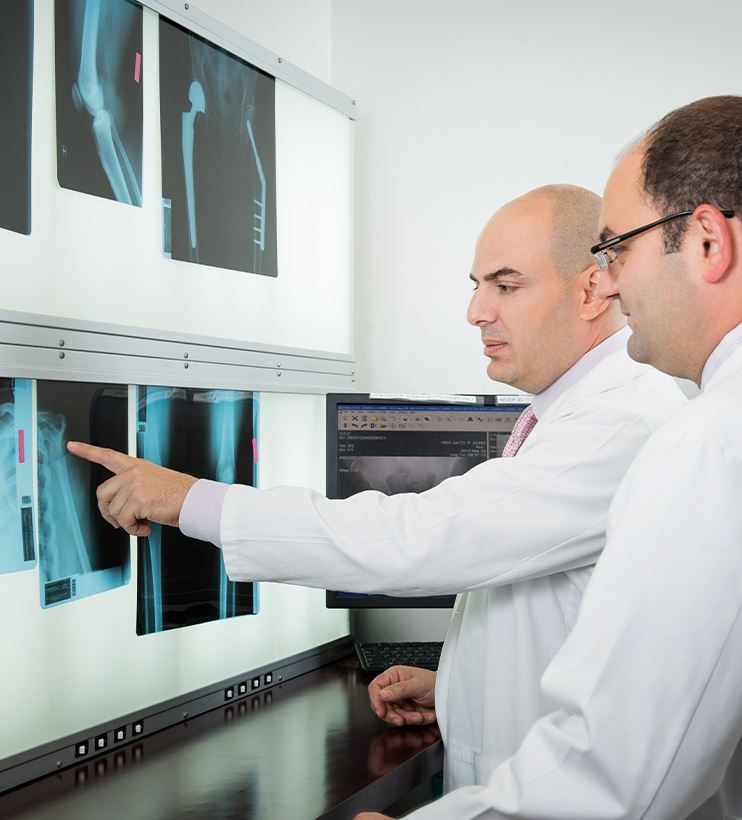
Arthritis
Our doctors can help manage your arthritis.
Healthy joints help your body move, bend, and twist. Knees glide up and down the stairs without cracking or crunching. Hips move you along on a walk without a complaint. But when you have arthritis, these simple everyday movement can hurt.

Common Symptoms
You may experience pain, stiffness, weakness, or have limited motion.
- Pain. Your joints may ache, or the pain may feel burning or sharp.
- Stiffness. Getting up in the morning can be hard. Your joints may feel stiff and creaky for a short time, until you start moving.
- Muscle weakness. The muscles around the joint may get weaker. This happens a lot with arthritis in the knee.
- Deformed joints. Joints can start to look like they are the wrong shape, especially as arthritis gets worse.
- Reduced range of motion and loss of use of the joint. As your arthritis gets worse, you may not be able to fully bend, flex, or extend your joints. Or you may not be able to use them at all.
- Cracking and creaking. Your joints may make cracking sounds.
Description of Arthritis
Arthritis is an inflammation of one or more joints where two bones connect. Osteoarthritis (OA) is the most common form of arthritis; this type degenerates the cartilage within the joint causing bone on bone contact, leading to pain, decreased mobility, and possibly inflammation. Other forms of arthritis can be autoimmune related as is seen with rheumatoid and psoriatic arthritis. These other forms can lead to severe disability, pain, swelling, and loss of function.
Common Treatments
There are many available treatments for arthritis, but what works for one may not be helpful for others. It is important to work with our OSS provider to find what is best for you. Physical therapy in combination with other therapies (whether it is a conservative approach or surgery) has been proven to be highly effective in treating your symptoms.
- Pain medication. If your pain is mild, over-the-counter pain medicines such as acetaminophen (for example, Tylenol) and nonsteroidal anti-inflammatory drugs (NSAIDs) may help. Commonly used anti-inflammatory medications include ibuprofen (such as Advil and Motrin) and naproxen (such as Aleve). But if these don't get rid of your pain, you may need a stronger prescription medicine such as Meloxicam (Mobic). There are also available gels (Voltaren gel) that can be applied on the painful joints.
- Hydrocortisone injections are used to treat swollen or painful joints, such as after an injury or arthritis. It is injected directly into the painful joint. It helps to relieve pain and swelling, and make movement easier. The joints most often injected are the shoulder, elbow, wrist, hand, hip and the knee. Once injected, the benefits can last for several months. Again, our OSS providers can recommend this procedure if it’s warranted.
- ViscoSupplementation “gel” shot is a gel-like fluid called hyaluronic acid that is injected into the knee joint. Hyaluronic acid is a naturally occurring substance found in the fluid that is surrounding the joints. It acts as a lubricant to enable bones to move smoothly over each other and as a shock absorber for joint loads. Osteoarthritis causes a lower-than-normal concentration of hyaluronic acid in the joints. Injecting hyaluronic acid to the arthritic joint will facilitate movement and reduce pain.
- Using heat or ice on the painful joint. Heat may help you loosen up before an activity. Ice is a good pain reliever after activity or exercise.
- Losing weight, if you're overweight. Losing weight may be one of the best things you can do for your arthritis. It helps take some of the stress off of your joints.
- Exercising to strengthen your muscles. Having stronger thigh muscles, for example, can help reduce stress on your knees. Swimming, biking, and walking are good activities. But make sure you talk to your OSS provider to determine what type of activities are best for you. The physical therapist would also be a great resource for you.
- Having surgery. If the pain in your joints do not get better with the conservative treatment, you may decide to have surgery to replace the arthritic joint.

